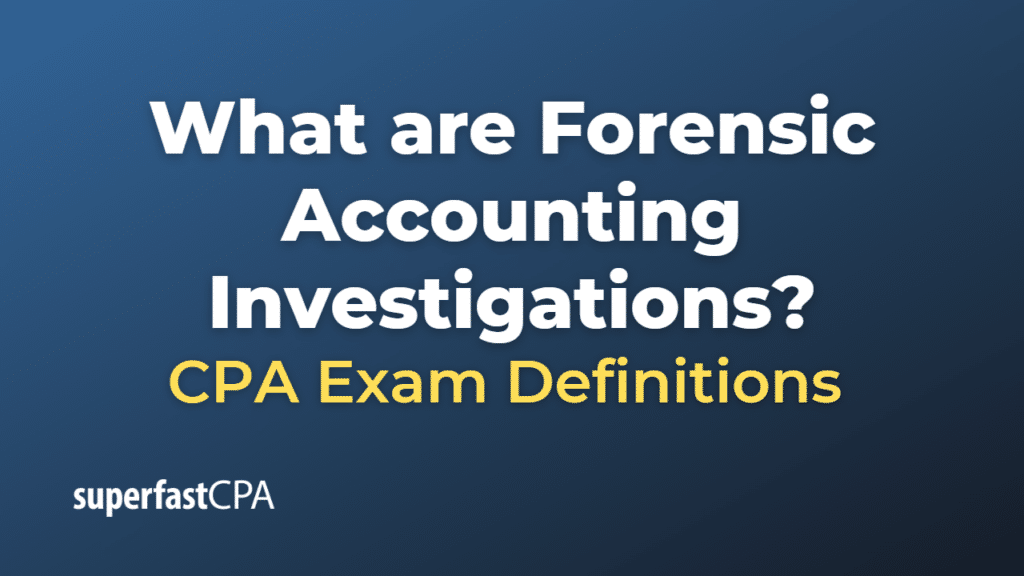Forensic Accounting Investigations
Forensic accounting investigations are procedures that forensic accountants carry out to uncover evidence of financial irregularities, fraudulent activity, or even to locate missing assets. The purpose of these investigations is to analyze, interpret, summarize, and present complex financial and business-related issues in a manner that is both understandable and properly supported.
Forensic accounting investigations can be conducted in a wide range of circumstances, including:
- Fraud Investigations: This is perhaps the most common type of forensic accounting investigation. If a business suspects that it’s the victim of an employee or external fraud scheme, a forensic accountant will analyze its financial records to determine if fraud occurred, how it was carried out, who was responsible, and how much money was lost.
- Disputes Among Shareholders or Partners: In businesses with multiple owners, disputes often arise over income, equity, and control. A forensic accountant can analyze, interpret, and summarize the financial information that’s central to the dispute.
- Business Valuation: For estate tax returns, divorce proceedings, mergers, and acquisitions, a forensic accountant might be asked to value a business.
- Economic Damages Calculations: Whether a business loss is covered by insurance or if a business sues another for economic damages, a forensic accountant might calculate the economic losses.
- Bankruptcy, Insolvency, and Reorganization: Forensic accountants can analyze financial records and transactions to ensure that everything is above-board and in compliance with laws during these proceedings.
- Matrimonial Disputes: In divorce proceedings, a forensic accountant may be asked to uncover and evaluate the value of marital assets when those assets are disputed.
- Post-acquisition Disputes: After a company is sold or merged, disputes can arise related to things like alleged misrepresentation of the company’s financials. A forensic accountant may investigate these claims.
These investigations can involve reviewing financial statements, tracing funds, identifying assets and liabilities, performing ratio analysis, and using computer-assisted audit tools to analyze thousands of transactions. The end goal is to gather all necessary evidence for a legal proceeding, or to identify weaknesses in procedures that have allowed fraud to occur so that those weaknesses can be addressed.
Example of Forensic Accounting Investigations
Imagine a scenario where an executive at a large corporation, “TechGlobal Inc.,” has been suspected of embezzlement. There have been substantial sums of money that seem to have vanished from the company’s accounts, without corresponding increases in business expenses or investments.
To investigate the situation, the company hires a forensic accountant. The forensic accountant begins their investigation by thoroughly analyzing TechGlobal’s financial records, including bank statements, credit card statements, receipts, and any other financial documents available. They also look at the executive’s personal financial records to see if there have been any significant changes in his financial status.
As part of the investigation, the forensic accountant employs various techniques such as data analytics to identify patterns and anomalies in the financial data, asset tracing to find where the missing money has gone, and detailed examination of transactions to identify any irregularities.
Through their investigation, the forensic accountant discovers several suspicious patterns. For instance, they find a series of payments to a shell company that the executive has been using to siphon off funds. The shell company seems to serve no purpose and has no employees or business activities. The payments to this company coincide with large deposits into the executive’s personal bank account.
The forensic accountant compiles all of this evidence into a comprehensive report and presents it to TechGlobal’s board of directors. The report details the fraudulent activities and presents a clear trail of the missing funds from TechGlobal to the executive’s personal account.
In this example, the forensic accountant’s investigation has provided TechGlobal with the evidence it needs to pursue legal action against the executive, and the information it needs to strengthen its financial controls to prevent future embezzlement.













